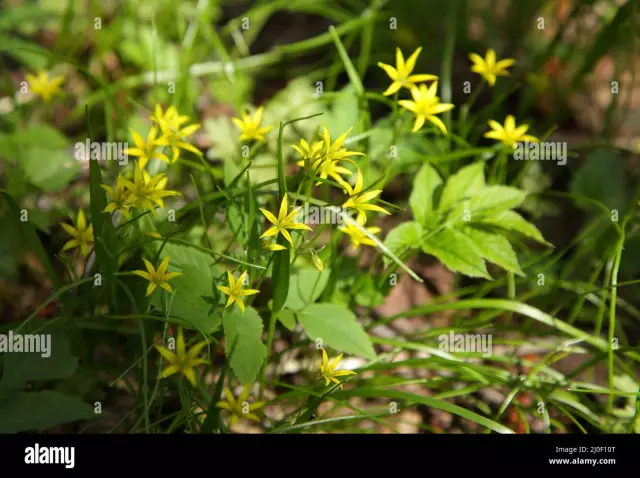- Author Rachel Wainwright [email protected].
- Public 2023-12-15 07:39.
- Last modified 2025-11-02 20:14.
Goose bow
Instructions for use:
- 1. Medicinal properties
- 2. Application in traditional medicine
- 3. Application in cosmetology

The goose onion (Gagea) is a short perennial bulbous plant of the genus Liliaceae that blooms with small yellow flowers. Popular names - yellow snowdrop, yellow goose, viper onion. The height of this plant is small, only 8-15 cm. The goose onion grows in the temperate zones of Eurasia, including Russia, Belarus and Ukraine. You can meet him in forests, steppes, mountain slopes, thickets of bushes. Of all the subspecies, the most common are the yellow Goose Onion (Gagea lutea) and the Lesser Goose Onion.
The healing properties of Goose Onions
For medicinal purposes, the bulbs and leaves of this plant are used.
Goose Onions are harvested either in the spring (before flowering) or in the fall. They contain vitamins (C, B, E, PP), minerals (including iodine), essential oils, inulin, carotene, sulfur-containing compounds, organic acids. This plant is close to garlic in its medicinal properties; its leaves can be used to make vitamin salads. The medicinal properties of Goose Onions have been known for a long time; it was used in the treatment of bronchial asthma, edema, hepatitis, and epilepsy. Yellow Goose Onion has a wound healing and antiseptic effect, the crushed bulbs of this plant are used topically for the treatment of wounds and long-term non-healing trophic ulcers.
Eating parts of Goose Onions (bulbs, leaves) for food allows you to replenish the deficiency of vitamins and minerals, which is especially important in spring during the period of vitamin deficiency.
Application in traditional medicine
For medical purposes, a universal broth is prepared from the onions: 1 tablespoon of chopped onions is boiled in 300 ml of water for 3-5 minutes, and then infused for 2 hours, filtered and cooled. Take a decoction of Goose onions should be 1 tablespoon 4 times a day (with asthma, jaundice, edema). Reception of this broth should be carried out in courses of 2 weeks (then a break is taken for a month, after which the course is repeated). It is necessary to store the goose onion broth at room temperature for no more than a day.
For the treatment and treatment of wounds and long-term non-healing ulcers, juice from the bulbs of this plant or freshly prepared gruel is used. Grated onion (or juice) is applied to the wound area (trophic ulcer) for a day. Then the dressing must be changed to a fresh one.
For the treatment of influenza and colds, it is recommended to ingest grated Goose Onions mixed with honey.

For the prevention of epileptic seizures, the broth is prepared in milk. Add several onions (3-5) to 130 ml of fresh milk and cook for 5 minutes. Then the milk broth of Goose onions must be filtered and cooled. Reception is carried out in 2-3 teaspoons 3 times a day. The course of taking a decoction is 2 weeks. Depending on the severity of the disease, the duration of admission can be extended.
The use of goose onions in cosmetology
Yellow Goose Onions are traditionally used in cosmetology. For better hair growth, you can make masks: 4 tablespoons of Goose Onion gruel are mixed with 2 tablespoons of honey and rubbed into the hair roots. The mask is left on for 30 minutes, after which the hair must be thoroughly rinsed with shampoo.
Also yellow goose bows are used as face masks. For problematic porous skin, the following mask is made: chopped onions are mixed with honey and applied to the face for 10 minutes, then washed off with cool water. Instead of honey for acne, egg yolk can be added to the mask.
For age spots, goose onion juice is used, it is applied to the area of freckles (age spots) 2-3 times a day. After that, being in the open sun is contraindicated for several hours.
There are practically no contraindications to treatment with Goose Onions. It should not be used only with individual intolerance.
Information about the drug is generalized, provided for informational purposes and does not replace the official instructions. Self-medication is hazardous to health!






